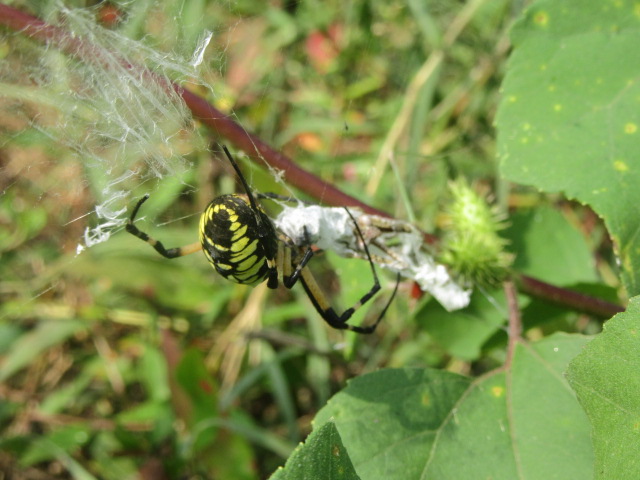
Argiope aurantia (Black and Yellow Garden Spider).
Hello everyone! I hope this post finds you all well. It’s approaching fall and the temps are doing their silly fall dance. I thought I would take a walk to the back of the farm on Sunday afternoon since I haven’t been back there for a while. The hay was cut a while back so walking through the grass wasn’t as hard as it was before. Ummm… Just between you and me, I took the walk and the photos on September 20. 🙂
Sometimes It is hard to decide what title to give a post, but this one because easier as I walked. By the end of the walk I had it figured out.
I walked around the back barn and noticed a Cocklebur. The plant itself wasn’t it great shape but that wasn’t what caught my eye. There was a HUGE Black and Yellow Garden Spider (Argiope aurantia) with a Praying Mantis in its web. The Praying Mantis was even longer than the spider. I haven’t seen any of these spiders around the house this summer which doesn’t mean they aren’t there. Truthfully, I have been busy and haven’t paid much attention to anything around the house.
From there I walked into the main hayfield…

Vernonia baldwinii (Baldwin’s or Western Ironweed).
Most of the wildflowers have run their course but there are still several that are still going at it. Some regrow after they are cut and start flowering again. The milkweeds, even though they won’t flower again, are some of the first to spring back into action after they are cut and they start growing like their life depends on it.
Vernonia baldwinii, commonly known as Baldwin’s Ironweed or Western Ironweed, is another wildflower that grows back quickly. There are quite few small colonies scattered throughout the pastures and hayfields and the butterflies were very busy on their flowers. They wouldn’t sit stilling enough to get a photo, though.
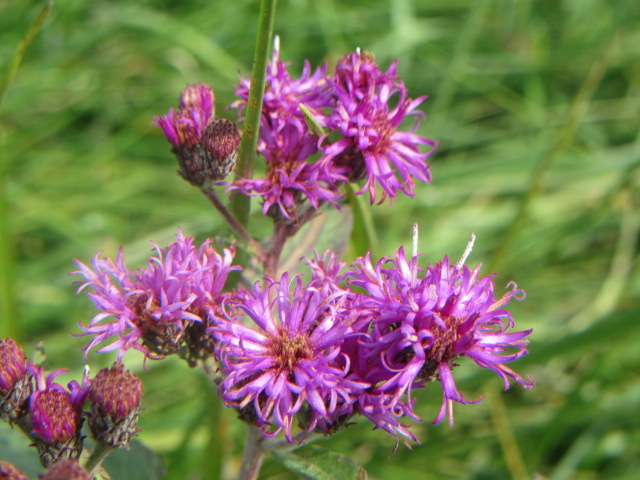
Vernonia baldwinii (Baldwin’s or Western Ironweed).
I uploaded the above photo on iNaturalist and it suggested it was Vernonia missurica (Missouri Ironweed). The Missouri Ironweed has appressed bracts while Baldwin’s Ironweed has curved bracts.
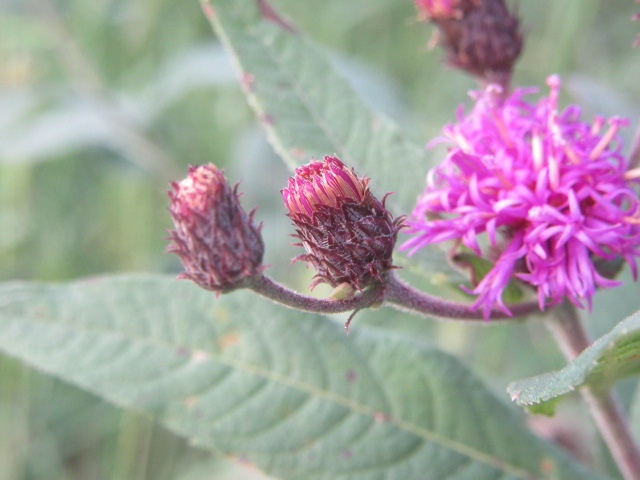
Vernonia baldwinii (Western Ironweed).
Of course, I had to go back to the pasture with my camera and a magnifying glass to make sure. I have been taking photos of these ironwoods for several years and they are indeed Vernonia baldwinii… But just to be safe, I checked numerous colonies…

Vernonia with appressed bracts.
Of course, there had to be a couple of colonies with flowers with appressed bracts. So, could they be Vernonia missurica? Hmmm…

Conocephalus fasciatus (Slender Meadow Katydid).
Besides butterflies, there were numerous grasshoppers, beetles, and other small and odd looking creatures on the plants and flowers. The sun was pretty bright and the wind was blowing so I didn’t get many good bug photos. The above photo of the Slender Meadow Katydid (Conocephalus fasciatus) came out very good. This is a third common species of Katydids that I see here. It is pointing out this Ironweed has appressed bracts… Thanks for pointing that out, buddy.
I went on to the pond in the back pasture to see what else I could find…
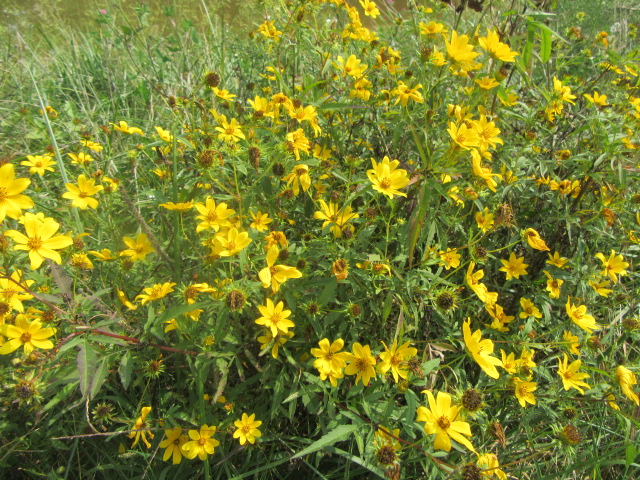
Bidens aristosa (Bearded Beggarticks, etc.).
This time of the year many pastures are aglow with the golden-yellow flowers of Bidens aristosa. It has many common names including Bearded Beggarticks, Western Tickseed, Long-Bracted Beggarticks, Tickseed Beggarticks, Swamp marigold, and Yankee Lice. Although the flowers look amazing in mass colonies, the seed is what most of the common names indicate. The seed has a couple of small stiff stickers that stick to anything crazy enough to walk through the colony. Can you imagine how many seeds you would have to pull off your clothes? Since I am aware of this I avoid getting to close when there are seeds present. The biggest colony here on the farm is around the back pond, but I have seen them in the lower end of the south hayfield as well. They prefer damp soil, especially in low areas.
A friend of mine sent a photo a few weeks ago asking if I could identify the plants in his pasture. I went to have a look in person and the entire low area along the highway and his pasture was filled with Bidens aristosa. It was quite a sight… Well, his woods are where I took most of the wildflower photos this past spring. This area was standing in water at the time.

Penthorum sedoides (Ditch Stonecrop).
One of several interesting wildflowers on the farm, the Ditch Stonecrop (Penthorum sedoides) likes growing along one particular area of the back pond.
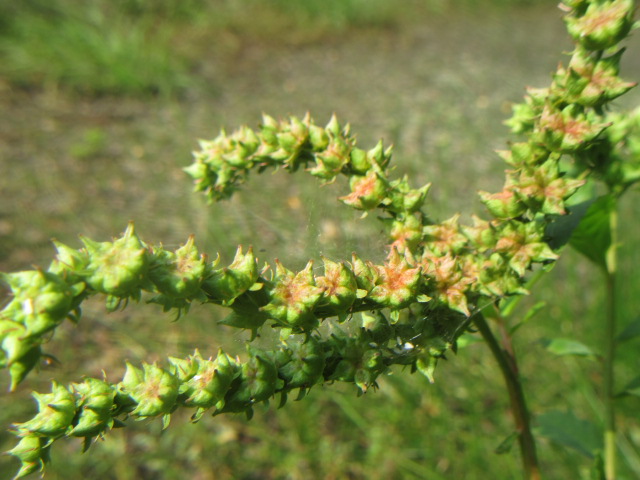
Penthorum sedoides (Ditch Stonecrop).
As usual, there were very few of its very odd-looking white flowers left but its fruit is also quite interesting.

Ludwigia alternifolia (Bushy Seedbox).
I wanted to get photos of the Bushy Seedbox (Ludwigia alternifolia) flowers earlier but I could never find the plants. For a while, I thought maybe they didn’t even come up. Fortunately, I was able to locate a small colony again but the wind was blowing so I couldn’t get good close-ups. The common name comes from the fruit being square like a box. Strange but true…
I always thought it strange the Bushy Seedbox is in the same genus as the Floating Primrose Willow (Ludwigia peploides) that grows in the ponds.

Eupatorium serotinum (Late Boneset).
There are plenty of the Eupatorium serotinum (Late Boneset) on the farm mainly closer to fence rows and areas that aren’t mowed. To me, its flowers look like Ageratum which is now Conoclinum… When I uploaded this photo on iNaturalist, a member disagreed and said it was Eupatorium serotinum (Late Boneset, Late Thoroughwort). He said to check the petioles… Hmmm… If I had have taken more photos like usual with I am identifying plants he wouldn’t have said that. The E. altissimum has narrower, lance-shaped leaves while E. serotinum has leaves that are broader at the petiole and taper toward the tip. I took photos of that species last fall growing along the fence behind the back yard.
Walking away from the pond, about halfway to the swamp…

Symphyotrichum sp.
Hmmm… There are multiple species in the Symphyotrichum genus that look so much ake I gave up on trying to tell them apart. Missouri Plants lists 14 species. Some have longer petals and some have shorter petals and some species are “variable”. They can have purplish or blueish flowers as well… They flower pretty much all summer right up until a hard “F”. There a lot of these on the farm and sometimes even the hayfields and pastures are full of them. Not just the hay fields here but other hayfields and pastures as well. This Aster species loves roadsides, fence rows, edges of pastures, and just about anywhere that can’t be mowed. They aren’t very showy because of their small flowers and to me, they just look like a weed. It is very bad to have a nice hayfield or pasture then all a sudden it gets covered with these.
I continued walking along the fence toward the southeast corner of the farm toward the swampy area. I had hoped to figure out what species of Panic Grass is growing in an area close to the electric fence that runs across the south end of the back pasture. But, no luck with that. It’s somewhat hard to explain this area and I suppose I should have taken a photo… The southeast corner is a grown-up mess that would like to get worse. Dad put up an electric fence between the boundary fence along the east side and hooked it up to the electric fence that runs along the trees between the back pasture and south hayfield… DEEP BREATH! Anyway, tree seedlings and blackberries just started taking over, and the deer continually ran through the fence. The largest Mullberry tree is also in this area with low limbs so moved the electric fence up past the tree. Limbs continually fall out of this tree and it was kind of a pain to always have to be repairing the fence.

Impatiens capensis (Jewelweed).
A few years ago, Jewelweed (Impatiens capensis) covered the swampy area but no more. The Canary Grass has taken over the swamp but the Jewelweed, being an invasive survivor, has escaped and is growing mainly along the edge now. It is also trying its luck along the south edge of the front pasture. Many low wooded areas along creeks are a great environment for the Jewelweed. They have neat flowers, but they become quite invasive and can displace native species after a few years.

Prunella vulgaris (Common Selfheal).
One of the neatest wildflowers on the farm is the Prunella vulgaris commonly known as All-Heal or Common Selfheal. It doesn’t get very tall but it manages to grow among taller plants and grassy areas along the edge of the pasture, fence rows. I even noticed a small colony close to the back pond last year. They have neat flowers that seem to pop out anywhere on the inflorescence with no particular plan in mind. I found these for the first time last year and what a find they are.
I wanted to walk along the edge of the south hayfield but I had to find a place to cross the fence when I am not met with poison ivy or some kind of stick tights or beggarticks…

Silphium integrifolium (Wholeleaf Rosinweed).
Hmmm… Don’t see many of these here especially where I found it. Normally the Wholeleaf Rosinweed (Silphium integrifolium) is growing along the edge of the hayfield where it hasn’t been mowed but this one is right out in the grass. I found the first one after it had flowered a few years ago along the edge of the back pasture (where I just left). The plant looked like it had neat green flowers but come to find out the petals had already fallen off.

Silphium integrifolium (Wholeleaf Rosinweed).
The Silphium integrifolium is quite a majestic plant that can get quite tall and can be found growing along back roads along fences.

Silphium integrifolium (Wholeleaf Rosinweed).
Their flowers resemble small sunflowers… Well, once they become flowers.
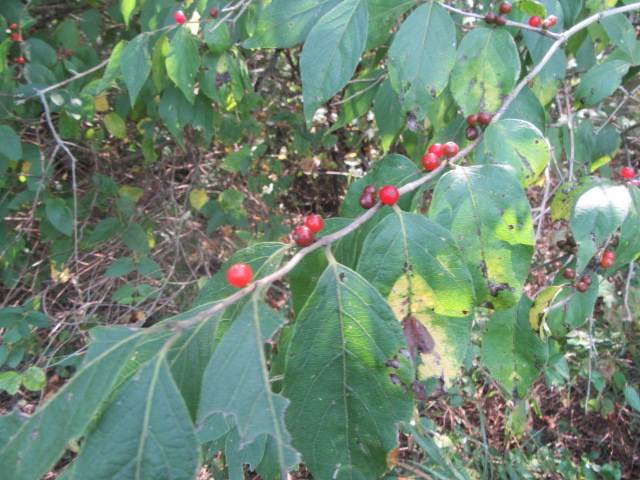
Lonicera maackii (Amur or Bush Honeysuckle).
The Lonicera maackii (Amur or Bush Honeysuckle) flowers are all gone but their red fruits dot their stems now. This honeysuckle is not invasive and has stayed put in the same spot along the trees in the south hayfield since I have been here.
Walking west along the edge of the south hayfield where it becomes a mess of blackberry briars, Japanese Honeysuckle, and whatever has managed to overwhelm or survive the border between the old railroad right-of-way. In some areas, the blackberries are growing out into the hayfield.
I contacted a man from the Missouri Department of Conservation about the area to see what could be done. The old Rock Island Railroad is now a trail that is part of the state park system. There is at least 30 feet between the boundary and trail that is overgrown mainly with blackberry briars, vines, and small trees. It is quite a mess and would make a great native wildflower habitat. The man I emailed replied and said he would love to visit but because of the virus he wasn’t able to come until restrictions had been lifted. That was back in April so I think another email to him is in order.

Argiope aurantia (Black and Yellow Garden Spider).
Lady in waiting. There were two more Black and Yellow Garden Spiders fairly close to one another hanging around in the vegetation along the hayfield. They were HUGE! I really love seeing these spiders and they bring back memories of when I was a kid. I never will forget the one that was in a web under the eve of our old chicken house where we lived when I was a kid. I would catch big grasshoppers and throw them in the web and watch the spider pounce on them and twirl them up like a mummy.
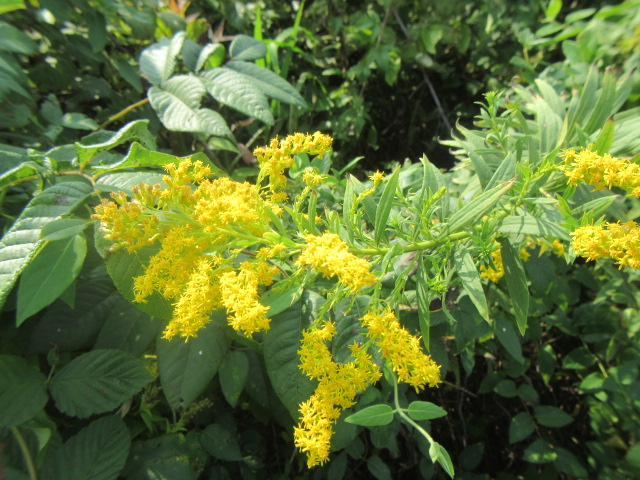
Solidago sp. (Goldenrod).
There are still quite a few Goldenrods (Solidago sp.) flowering but many are also starting to go to seed. There are numerous species of Solidago in Missouri that are very similar so I haven’t ventured to figure out which one(s) are growing here. The Missouri Pants website list 13 species. I have noticed some differences between some of the colonies here but they may also be variable. Last year there was a HUGE colony next to one of the Mulberry trees in the front pasture where they hadn’t been before. This year they didn’t even come up… Weird.

Symphyotrichum sp.
This is another of the complex Symphyotrichum genus. This colony has purplish-pink flowers. Kind f hard to explain the color. They have kind of a bluish, purplish, pinkish color. GEEZ! Now, while most of these plants grow between 24-36″ tall, some can get much taller. Along the fence in the front pasture, I have seen them grow well over 6 feet tall. I would say 8 feet but you would think I am exaggerating… There is another genus with similar flowers, also beginning with an “S”, but I cannot think of it at the moment…

What a variety…
This photo is where I came up with the title “I Love You, I Hate You” and maybe should have been the first photo on the post. Probably my favorite wildflower in this photo is the white flowers of the Eupatorium altissimum. They really do look like white Ageratums. The worse is of course the seed of the Desmodium species or Beggarticks… Of course, the blackberry briars by themselves would keep anyone from diving in… It is just incredible how many species of plants you can name in some photos… I see at least five in this one. 🙂

Darn it!
I looked down at my pant legs and no matter how much I try to avoid it, I always manage to wind up with beggarticks… It’s not the ones you notice and not walk in that get you. It’s the ones you don’t see that wind up on your clothes.
I reached the end of the south hayfield journey and decided to walk along the fence in the front pasture. So, I went through the gate and around the fence to the south side of the front pasture that borders the trail. Again, the area between the fence and trail is a jungle of briars, vines, and small trees. There are big trees along the trail, of course, but it is the area between that you don’t want to walk in…
I walked along the fence then crossed the ditch that runs from the big pond and behind the smaller one. The ditch goes to a culvert that runs under the trail that goes to a ditch that drains into the park lake. When I crossed the ditch I saw them… I had seen them last year but I didn’t take their photos.

Humulus lupulus (Common Hops).
It is pretty funny to think I had contemplated buying hops seed to grow on a trellis a few years ago only to discover a vine growing in the trees over the fence. This is Humulus lupulus also known as Common Hops. It is pretty unmistakable when you come to think of it, but I couldn’t think of what it was because it never entered my mind that there were hops growing in the wild along the fence.
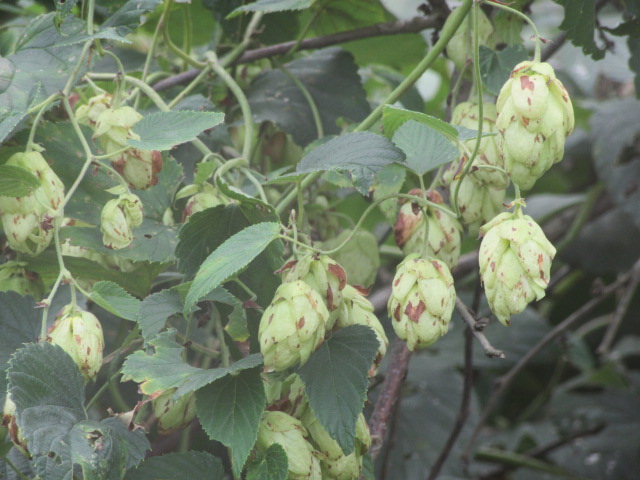
Humulus lupulus (Common Hops).
I uploaded the photos on iNaturalist and it gave me two choices for Humulus. One was this one and the other was the thorny species Humulus japonicus… The two also have different leaves.
Up a little bit from the hops is probably the most interesting plant on the farm and I was glad to see them again. I first identified this species in this same location in October 2018…

Verbesina virginica (White Crownbeard).
This is the awesomely amazing Verbesina virginica commonly known as White Crownbeard AND Frostweed. The name Frostweed comes from its peculiar frozen “flowers” that emerge from the stems during the first hard “F” (OK, freeze). I have only seen photos so I must remember to go and have a look when that dreaded time comes. It may very well be the highlight of the winter. It is actually caused as the water inside the stem freezes causing the stem to bust creating an icicle.

Verbesina virginica (White Crownbeard).
This species grows very tall and produces large clusters of white flowers. Its cousin, Verbesina alternifolia known as the Wingstem, produces very interesting yellow flowers. I photographed that species for the first time at a friend’s farm in September 2019. I found another colony along the Tebo Creek when on the wildflower hunt this past spring. I really need to go to Jay’s farm where I photographed their flowers last September or to Kevin’s woods along the creek (s) to see if I can get new photos of their flowers.

Verbesina virginica (White Crownbeard).
There were quite a few interesting critters on the White Crownbeard’s flowers.
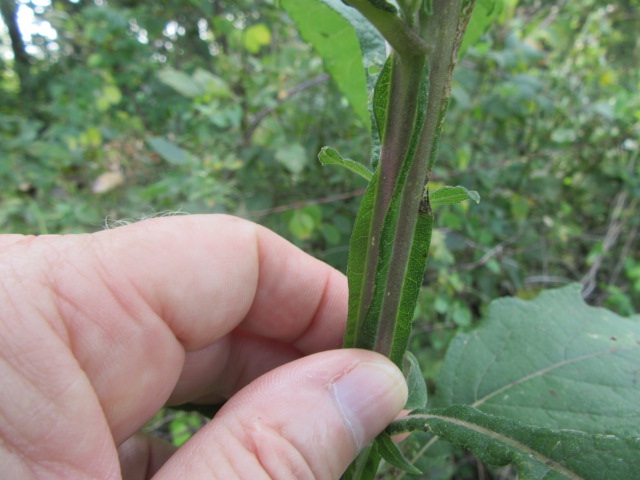
Verbesina virginica (White Crownbeard).
One of the interesting features both Verbesina virginica and Verbesina alternifolia have in common is their unique winged stems. For some reason, I am amazed by weird stems…

Ancistrocerus campestris (species of Potter Wasp).
Several wasps were busy snacking on nearby asters. This particular wasp is Ancistrocerus campestris which is one of several species of Potter Wasps.
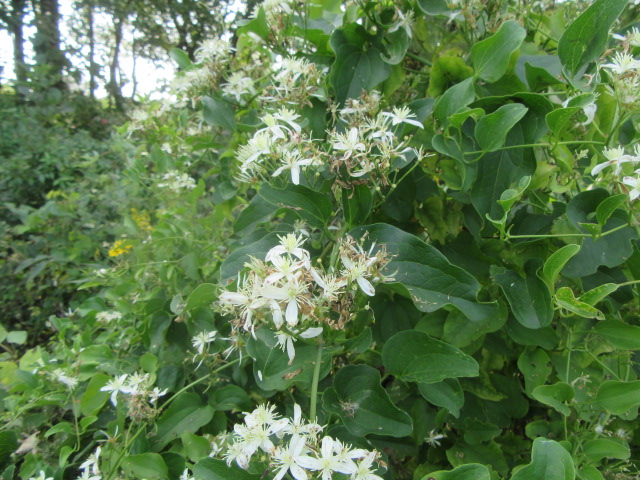
Clematis terniflora (Autumn Clematis).
The Autumn Clematis (Clematis terniflora) has not gotten too out of hand which has surprised me. Please don’t quote me, but I think it is a neat vine. It has been in this same spot for several years without spreading that much…

Clematis terniflora (Autumn Clematis).
Well, it did spread a little… Now it is growing on the fence along the street where it gets more sun which apparently made the flowers fade sooner. The flowers are nice, but the fruiting phase is plain weird.

Strophostyles helvola (Amberique Bean or Trailing Fuzzy Bean).
Walking on up the fence in the front pasture I realized I missed the Strophostyles helvola flowering AGAIN. Its common name is Amberique Bean or Trailing Fuzzy Bean. I first noticed it last September when there were a few flowers and beans on dead stems just like now. I looked for it earlier in the summer but couldn’t find it. I need to tie a piece of material on the fence to mark its location…

Strophostyles helvola (Amberique Bean or Trailing Fuzzy Bean).
Maybe I should take some of the seeds and scatter them along the fence here and there. 🙂
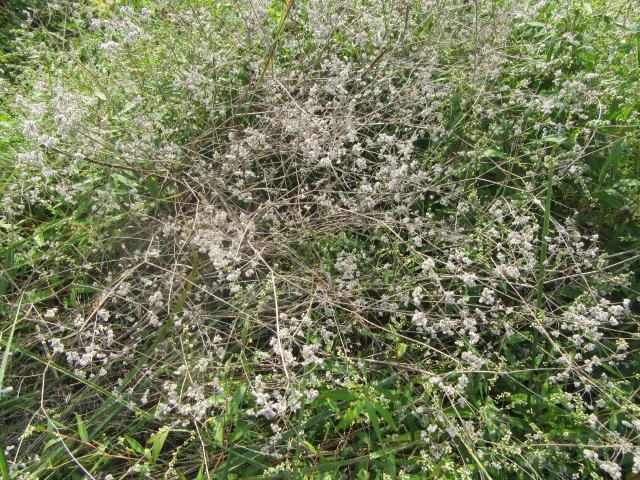
Torillis arvensis/Torillis japonica (Japanese Hedge-Parsley).
While I don’t like the velcro-like seeds of Beggarticks, I really dread the seeds of the Hedge Parsley. There is somewhat a controversy of whether Torillis arvensis and Torillis japonica are the same species or distinct species and which one is the Upright Hedge Parsley or the Japanese Hedge-Parsley. Even whether or not to use a “-” between Hedge and Parsley. Plants of the World Online list both species as accepted for the moment… It doesn’t matter to me which is which I just try to avoid them this time of the year. I have hated getting the stick tights on my clothes ever since I was a little kid. I would come inside with the stick tights on my socks and throw them in the hamper like that. Mom complained about it because she had to remove the stick tights. Then she decided to teach me a lesson and she left them on my socks… GEEZ!!! After that, I picked them off myself but soon learned not to get them on my socks in the first place…

For crying out loud! Now I have stick tights on one leg and beggarticks on the other… Believe me, I have had them much worse. I am still learning to wait until I am finished walking before removing them.

NORMALLY in the spring and during the summer when I see a Cocklebur I get rid of. However, with the pasture being leased for the past couple of years I have neglected to do that. When I had cows they kept the grass short and I could easily walk through the pasture and cut the thistles and pull up certain weeds. Some are easier to spray. BUT, with the pastures being used for hay now, walking through the tall grass isn’t so easy. I guess that is a pretty good reason for being neglectful. Reason or excuse, I still don’t like unwanted weeds. The difference between a weed and a wildflower, in my opinion, is that a wildflower has more than a few benefits to the environment, insects, not too invasive, doesn’t have seeds that stick to your pants, etc. A weed, although it may be a wildflower of sorts, produces massive amounts of seed and becomes invasive and hard to control, has awful fruit or seed that sick to everything, and a plant that I just don’t much benefit from it. What is a cocklebur good for? I have no idea and I don’t really care to do research to find out…
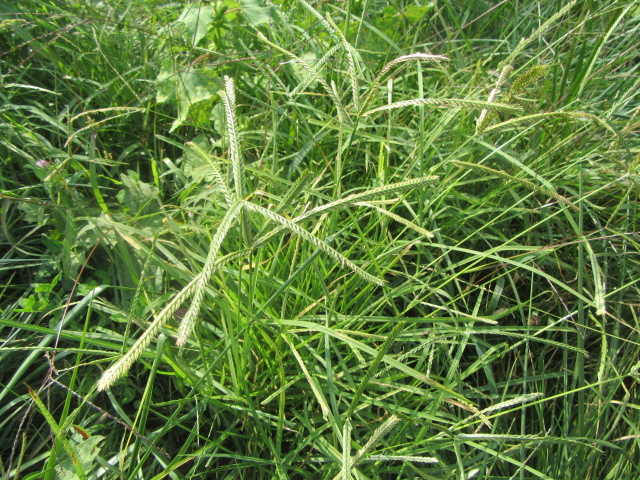
As I as getting ready to end my walk, I stumbled upon a patch of the DREADED Crowsfoot. Of the multitude of grass species growing on the farm and in the yard, Eleusine indica is the worse. It’s blades are very tough and its roots are firmly anchored into the soil. You can’t pull it up and when you mow it with a lawnmower you have to mow over it several times.
WHY DO WE HAVE TO CHANGE WHEN WE DON’T WANT TO?
Well, this post started out well even though it took a while to get it finished. When I started to finish up this afternoon I only had two more photos add. BUT I was greeted with something I had managed to escape from for quite a while… There it was happy to greet me and help with my post… The new block editor. I figured sooner or later I would have to accept things not looking like they always do when I am writing a post. I don’t want to figure it out… I don’t want Facebook to change the way it always looked worked for me either. Why don’t we have a choice? You would think with all the negative reviews and feedback they would get the hint and make the new look optional. Or at least make the old way optional.
You can tell where I added the photos with the new editor because the captions are different. GEEZ!!!! NOT FUNNY even though I had to laugh. 🙂
Well, I was at the end of this post anyway… Until next time, stay well, be safe, stay positive, always be thankful and GET DIRTY if you can.
I loved your walk. And all the flowers and bugs, the spiders not so much, but they are part and parcel of our lives. Well done!
LikeLike
Hello Linda! Glad you enjoyed the post. I am not a big fan of spiders like Brown Recluses, but I have learned to appreciate outdoor spiders. They are tremendous workers. I think I will be having more time now for more blog work. Oh, but then I have to figure out how to use the new editor or get the old one back. GEEZ! Thanks for the comment and take care!
LikeLiked by 1 person
I didn’t use the new editor, I tried it and didn’t like it.
LikeLiked by 1 person
I played around with the new editor a few times but it didn’t impress me. Now I can’t figure out how to get back to the classic like it was before. I don’t like to be forced to “adapt” to something I don’t want to do… Before I could just try it out, now it is just there automatically. I have been using basically the same editor since 2009 now I have to change? I don’t think so… 🙂
LikeLiked by 1 person
A beautiful post – had to go to the dentist yesterday so it cheered me up to walk along with you this morning & see the flowers & insects you have found. Katydids are fab aren’t they & such a brilliant name! To me those white asters are really lovely – like stars ⭐️ Not weeds! 🤨😂 thats the beauty of plants though i guess, we all have our own heroes & villains – stay well
LikeLiked by 1 person
Hello Debbie! Glad I could cheer you up after your visit with the dentist. There are still a few wildflowers to post about though most have gone to seed now. Katydids are interesting critters for sure. There were a lot of weird bugs on the walk but I couldn’t get very good photos. The light and wind just made it impossible and the butterflies wouldn’t sit still. The small white asters are definitely not my favorite wildflowers but I suppose that is because sometimes they invade the hayfields. Not much forage quality. 🙂 I guess they are OK along the fence rows. I hope you are well. Take care and thanks for the comment.
LikeLike
I admit to feeding the garden spiders when I was a kid.
On a recent walk, we found some of the hops. It was a surprise.
I am not happy that facebook forced change upon us. I think it is to accommodate those who primarily use phones or tablets to navigate.
I refuse to use the block editor in wordpress.
LikeLiked by 1 person
Hello Jim! You never know what you will discover while walking. I find something different every time I walk around the farm. I don’t mind upgrading to better things like a new coffee pot or TV, but having to change the way we write posts or navigate on Facebook to find what we need to find is nuts. So much advertising on FB now where fiends posts should be isn’t right. I upgraded to a personal plan in WordPress which is supposed to have live chat support. I was going to quiz them about getting back to the original editor like I had always been using. Strangely enough, there wasn’t an option to chat with support even though that is one thing I am paying for… I think more changes are in store as support finds out its members may not put up with it. Not just on WordPress and Facebook. Take care and thanks for the comment!
LikeLike
Rhody collects those hedge parsley thingies. I know it as just parsley (but not what grows in the vegetable garden). I do no know the species, or even if it is native. It is just nasty!
Your wildflowers are so much more fun. There are a few here that are pretty enough for me to want to grow them in the garden. However, they just do not adapt to garden culture well at all. Some will not survive supplemental irrigation. Others just look rotten all the time. The healthiest sorts are dead through summer.
A new weed arrived here a few years ago. It looks just like white crownbeard. I will go out to see how it compares. I potted some before I realized what a weed it is.
LikeLiked by 1 person
Nope; the flowers were similar, but the foliage is not.
LikeLiked by 1 person
Ahhh… Some other weed? 🙂 You can put it on iNaturalist and see what it is. Take photos or all parts.
LikeLiked by 1 person
Yes, some other weed. I still like it though. It has not offended me yet. Those identification apps are no more accurate than I am. I suspect that someone in the neighborhood knows what it is.
LikeLiked by 1 person
I agree about the apps sometimes. But, sometimes they are helpful to get you headed in the right direction. I did without iNaturalist for many years and did pretty well.
LikeLiked by 1 person
Hello Tony! I was thinking I can’t imagine anyone collecting stick tights then I remembered who Rhody was. The cats don’t seem to have much of a problem with them but sometimes the cow’s faces would be covered. Of course, I would have to make fun of them for it. Wildflowers do much better growing where they want to. Even if you were to scatter a wildflower mix very few species would survive for a long period. Maybe that’s just my opinion and I haven’t tried it. That’s interesting how you potted a weed. LOL! Well, I guess it isn’t a weed if you like them, huh? Take care and thanks for the comment!
LikeLiked by 1 person
Actually, that is an accurate observation. Of course, it does not prevent me from scattering wildflower seed anyway. Actually, I would be more hesitant to do so if I thought that some could naturalize and become invasive.
LikeLiked by 1 person
Well, you need to purchase a mix of wildflowers that are native to your area. Personally, I would rather choose what wildflowers I want growing in certain areas so I could take better photos of specific species. The reason I haven’t done that already is because I have been observing what comes up on their own. I do have areas I could plant a mix closer to the house but on the rest of the 40 acres, I prefer to let them naturalize on their own.
LikeLiked by 1 person
In some ways, it was easier in town. I was not concerned about potentially invasive exotic species escaping into the wild. They had no place to go. However, there was not much space there for wildflowers. A neighbor next door liked wildflowers in the unused yard between our driveways, which was less than fifty feet wide, and twenty feet from front to back. Now, there is plenty of space, but I must be more discriminating. There is actually a feed and hardware store in another town that sells native wildflower seed, along with erosion control seed, cover crops and such. I could get blends, or just a bunch of the same thing. Just a pound of California poppy seed goes a LONG way!
LikeLiked by 1 person
I have seen entire yards converted into a wildflower habitat that looks pretty good for a few years. After a while, some fizzle out and other more dominant species take over. There used to be a few poppies in my grandparent’s yard but somehow they also eventually stopped coming up. I would like some of the blue poppies…
LikeLiked by 1 person
Chaparral and desert wildflowers are not as pretty into the summer like they are in other regions, although I still think they are prettier than what passes for ‘landscapes’ in some situations. In parts of the Mojave Desert, front yards are covered with stone (like those old fashioned ‘moon stone’), and then covered with gunite or foam roofing!
Blue poppies do not likely grow as wildflowers. I think they take a bit of effort to grow, which is why they are not more popular.
LikeLiked by 1 person
Many wildflower species here also fizzle out in the heat of the summer. I can’t picture front yards being covers with roofing. You mean like shingles? Sounds like a Horridiculture post fr you. Poppies used to be more common in older landscaping. For the most part, the poppies in my grandparent’s yard just grew out in the lawn and along the fence. They were bright orange.
LikeLiked by 1 person
The roofing is that spray on foam that looks like flocking on old fashioned Christmas trees. It might be pastel green, but is sometimes white, grey, tan or (seriously!) pastel blue, pastel yellow or pink!
The California poppy is bright orange. Others are orange too of course. Nowadays, California poppy is available in a weird variety of unnatural colors. Simple orange is still the best.
LikeLiked by 1 person
Well, I would have to say it would look strange. I wouldn’t do it. 🙂 I always thought the Himalayan Poppies would be great but they don’t survive here.
LikeLiked by 1 person
It does look strange, but people who live in such horrid climates rarely go outside to notice . . . or just do not care.
LikeLiked by 1 person
🙂
LikeLiked by 1 person
You have many of the same species of “stick tights” as we do. It matters not what specific species, those nasty seeds stick to everything, and we and the animals broadcast them, as does the wind and water. One thing I’ve learned though, certain species might be prevalent for a year or a few years, but then dwindle back and they seem to disappear for a while. Hedge parsley was horrible for the last four years, but this year I only see small areas of it.
So far I’ve managed to use the Classic Editor. I have tried the new format but I am completely frustrated with it and have to research too long to figure out some aspects of the changes. I do not have time for that. Also, I do not like supporting any Liberal-based company, which is why we deleted our Facebook profiles. I haven’t missed it one bit. It is possible I may have to end blogging as well. My inner instinct leads me to feel in these uncertain times, the less I put myself and my life out there, the better all around. It is what wildlife does when their way of life becomes threatened.
LikeLiked by 1 person
Hello Laura! It is very odd how nature is. Like you said, some years certain species are abundant then others there aren’t so many. It is also weird how some new plants just pop up out of nowhere I never saw here before. Even one hedge parley is plenty.
Before the end of this post, I was still using the “normal” editor. It took over a week to finish, and then when I had time to complete the last of the post it just started out with the new one. That was quite a shock!
I use Facebook to stay connected with friends and family but I no longer put my blog posts on Facebook. Before it was automatic, but now WordPress doesn’t support doing that. I did subscribe to Twitter and posts automatically get posted there. I am not a Twitter fan, though. I don’t really want to stop blogging because I enjoy sharing posts and plant information. I feel the blogging community has become quite like family and I get to share my opinions here with like-minded people and get their opinions as well. We seem to still have a lot of freedom here to express our thoughts. Yes, we are more or less putting ourselves “out there” but I am not conspiracy theorists nor am I paranoid about what could happen. When wildlife is threatened is moves on to another area and resumes life elsewhere and adapts to those surroundings. As humans, we get comfortable and are somewhat reluctant to change and adapt. I agree, sometimes there may be an underlying agenda from the liberals which I will not support either, whatever their agenda may be. Just be yourself and do what you feel comfortable doing. Use common sense and your best judgment.
Take care, my friend, and thanks for the comment!
LikeLiked by 1 person
What a remarkably good post! It’s like a small book, full of lovely photos, vigorous prose, and lots of information. I can’t retain it all, but I can come back to the post. I want very much to learn more about plants. The katydid and spiders are bonuses. Thanks.
LikeLiked by 1 person
Hello Rose Marie! Thanks always for your wonderful comments! When I go for a walk it just seems like life unfolds in front of me in all directions. It is so refreshing to see how nature progresses with the seasons and how it moves from one phase of life to another. Taking it all in is one thing, but taking photos and writing about the experience is another. Finding the words express how amazing life is can be a bit of a challenge. Learning about plants is part of an exciting journey that is never ending. There is always something new to see and write about. Many insects are doing all they can now to survive their last days and to insure their species continues in future generations. Some are preparing for hibernation, too. Take care always and thanks again for your comments!
LikeLike
As usual you covered a lot of ground on this post! I’m amazed by how well you can dig through all the fine points of wildflower ID, I think I give up too fast or don’t give things the attention they need.
I was interested to see you having the same problems I’m having with the new editor. I just like the old way of captioning photos and don’t like the new look. I guess I’ll have to move on but… the new way should add, not leave you with less.
Have you looked at any of the new ‘styles’? I don’t want to spend hours messing with that either.
LikeLiked by 1 person
Hello Frank! Learning wildflower ID isn’t that hard when you just have a few species to learn. Here on the farm, I am always finding new species popping up. I did seem to get a bit carried away in a friend’s pasture last summer and his woods this past spring. All the different species was a lot to take in.
I did figure out how to get to the classic editor right off the bat. When you go to add a new post, there is an arrow next to it where you can choose “block editor” or “classic editor”. I haven’t added a new post since I noticed that, but hopefuly it will work like I am used to. I look at new themes and this and that from time to time but for now I will stick with the way my blog looks. It doesn’t hurt to change as long as it ultimately works for you and looks the way you envision it looking. The old theme I used in Mississippi isn’t available any longer but I really liked it. The first theme I used for the Belmont Rooster in 2013 also isn’t available so I had to pick a new one when I started again. I haven’t checked the themes lately and I certainly don’t want to screw up this one. 🙂
Take care and thanks for the comment!
LikeLike
Hmm. I was able to get right to the classic editor, but then it still puts me into the block editing when I go to dd a new post. Let me know if you get around it on your next post!
I just want to post a few pictures and write a little bit about them, I’m not sure why I need all this block stuff lol
LikeLiked by 1 person
Just click on “posts” or ‘all posts” then at the top right you will see an arrow next to “add new”. Click on the arrow and choose classic editor.
LikeLiked by 1 person
You are so lucky to have so much beautiful flowers and nature right in your backyard (even if it is a farm lol). This was an amazing post and you are so knowledgeable about the types of plants.
LikeLiked by 1 person
Hello Diane! I enjoy living here but I think I would enjoy living anywhere I can have some space to garden and grow plants. It is normally very peaceful here and I enjoy walking around on the farm to see what nature is doing. Always something different to learn about. Take care and thanks for the comment.
LikeLiked by 1 person